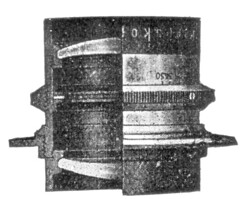Difference between revisions of "Periscopic lens"
m (removed Category:Lens; added Category:Lenses using HotCat) |
m (Added wikilink to meniscus achromat) |
||
| Line 11: | Line 11: | ||
Its simplicity (with no cemented elements) makes it cheap, and such lenses are found quite widely on simple popular cameras (for example cheap folders like the [[Vest Pocket Kodak]] and the [[Kershaw Eight-20 Penguin]], and some box cameras). | Its simplicity (with no cemented elements) makes it cheap, and such lenses are found quite widely on simple popular cameras (for example cheap folders like the [[Vest Pocket Kodak]] and the [[Kershaw Eight-20 Penguin]], and some box cameras). | ||
| + | |||
| + | An alternative lens for similar applications is a [[achromatic lens|meniscus achromat]], in which two cemented elements of different glass combine to give greatly reduced chromatic aberration. | ||
| + | |||
Revision as of 18:16, 20 May 2012

|
| Ica Periskop (Image rights) |
A periscopic lens is a symmetrical lens, consisting of two equal convex meniscus elements with the aperture between them. It was first made by Steinheil in 1865 (the origin of the name is simply that Periscop was Steinheil's name for their product).[1]
The symmetrical structure has advantages; in principle, the chromatic aberration, image distortion, and some other faults, of the second element would exactly cancel out those of the first, but only in the unrealistic situation where the subject and image distances were the same; in real situations, however, the aberration is still greatly reduced in comparison to an equivalent single meniscus.[2]
Its simplicity (with no cemented elements) makes it cheap, and such lenses are found quite widely on simple popular cameras (for example cheap folders like the Vest Pocket Kodak and the Kershaw Eight-20 Penguin, and some box cameras).
An alternative lens for similar applications is a meniscus achromat, in which two cemented elements of different glass combine to give greatly reduced chromatic aberration.
- ↑ Steinheil catalogue, 1925 (history, on page 2) at Camera Eccentric.
- ↑ Greenleaf, Allen R. (1950) Photographic Optics. Macmillan, New York. p65.